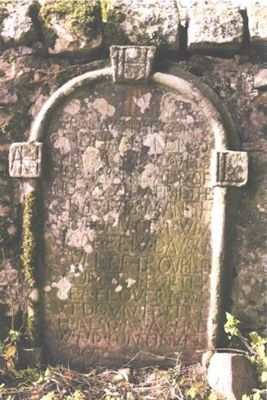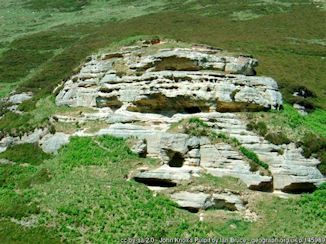The Covenanters Struggle in Kinross-shire

The headstone records that Robert Stirk and his family were exiled from Kinross-shire for 5 years.

The image of
John Knox's pulpit, Glenvale is evidence of the lengths people would
go to in order to worship as they wished
Link to the work produced by local children for the exhibition
Did
you know that some 350 years ago the local people in Kinross-shire were
hunted and arrested, fined or sometimes put in prison by the soldiers
of the King’s army? All across the lowlands of Scotland people were
ill-treated and lived in fear, and this continued on-and-off for around
50 years.
It started when the king ordered changes in the Church of Scotland which
the people would not accept. In those days the church was at the heart
of Scottish life, and everybody attended the service each Sunday. Every
county in Scotland was divided into parishes, each with a minister appointed
by the laird, who looked after the church helped by a group of elders,
the Kirks Session. The king ordered that the Church would have bishops
in charge instead of the local groups and a new prayer book was to be
used in church services. It would be a crime, punishable by death, not
to obey the new rules. However, many thousands of people objected and
signed a new document – the National Covenant – which declared
respect for the laws of Scotland but insisted that God was the head of
the church, not the king. Those who supported the Covenant were known
as Covenanters. The king was furious at such disobedience and declared
war on the Covenanters, making their lives very difficult over the next
fifty years.
All over Lowland Scotland, including Kinross-shire, ministers refused
to accept the new ways and were thrown out of their parishes and forbidden
from holding services. Some took to holding secret services in houses
and barns locally or out in the countryside in the open air; these were
called field preachings. Troopers (soldiers) were sent to scour the countryside
for these meetings to break them up and arrest those attending. A popular
spot was Glenvale, the secluded valley behind Bishop Hill where there
is a natural rock formation called John Knox’s Pulpit; here ministers
could preach to those gathered, whilst look-outs would be positioned on
the surrounding hill tops to warn of the approach of any troopers. These
meetings drew people from a wide area – Cupar, Kirkcaldy, Saline,
Dollar and even Perth.
Those caught at these meetings could be arrested and fined or put in prison.
In later years they could be executed or transported to Edinburgh, London
or even overseas. Some men were forced to leave their homes to avoid arrest.
The troopers could seize their possessions, crops or their livestock.
Locally the troops were led by Captain Crawford, known as Powmill, from
the name of his farm near where Loch Leven’s Larder is today. In
1675 the captain and his troopers raged through the county forcing many
to flee. Once a preaching at Glenvale was interrupted by the warning sound
of the horn, and the congregation scattered as the troopers approached.
Old John Gibb, the farmer at Pittendreich was hurrying past Crawford’s
farm, trying to escape, when he spotted the captain in his yard. Gibb
pleaded with his neighbour to hide him and although Crawford was a fierce
and ruthless man, he told the old man to go and hide in the boxbed in
his kitchen, saying “The troopers would never look for a Saint in
Hell.” When the troopers appeared, the captain sent them off down
the road. He was not so generous to others who were arrested and sent
to the tolbooth (prison) in Cupar and on to Edinburgh.
On another occasion the troopers were warned of a secret meeting at Glenvale
and reached the foot of the hill before they were discovered. As they
tried to climb up, stones and rocks were hurled down on them as the congregation
made their escape.
The determination of the Covenanters was so strong that when the troopers
left the country, the secret meetings started again. However, the troopers
returned from time to time to enforce the ban on illegal meeting and the
punishments grew more severe. Robert Steedman, a maltman (brewer) was
one who was hunted but managed to escape. In retaliation, the troopers
broke open the malt loft and removed as much malt as they could, even
taking the sheets off the bed to make more sacks to carry it away. Robert’s
wife was driven from her house and not allowed return for eighteen months,
on pain of more punishment. Others lost their crops which were used to
feed the troopers’ horses or their livestock. Some suspected of
being Covenanters had troopers lodged in their homes to keep an eye on
them.
The struggle of the Covenanters continued until the king died and the
new king allowed freedom of worship once more. In 1690 the Protestant
faith was restored and the traditional church was re-established.
There is a Covenanter’s grave in the old Orwell graveyard close
to the path round Loch Leven. It is a memorial to Robert Stirk, a merchant
of Milnathort, who, with his family, was forced to leave Kinross-shire
for eight years until the restoration of religious freedom. It is an important
reminder of the turbulent years when local people were harassed and lived
in fear of the soldiers of the king.